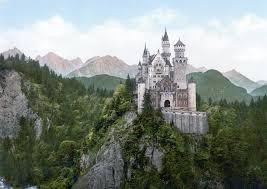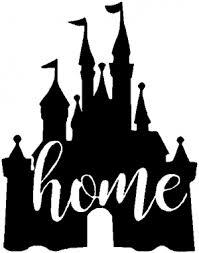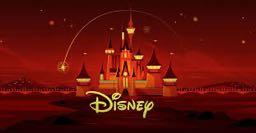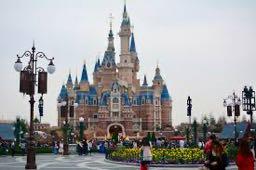
Disney castle: semiotics and variation
The icon of the Walt Disney company that can be found in six parks around the world and before any of its movies is the famous Disney castle. This piece of iconography and architecture is widely known all over the world and an icon of both the company and the country it represents.

Schloss Neuschwanstein: an important inspiration for the Disney Castle
Just like these two it borrows many cultural elements of Europeans countries. Specifically, its architecture is an homage to Neuschwanstein castle. (Knapp,1999) This is a romantic castle which itself alludes to medieval castles. This is notable by the fake messiculations and turrets. Over the years many versions of the castle have been made. Cinderella, sleeping beauty and other versions exist. However, the one that was built for Disneyland in Anaheim California can be considered the original. What is it about this castle that is so iconic and what does this mean? What is its value as a visual cultural metaphor and what is its value in the study of visual culture? Lastly what are differences and similarities between the original and its many copies? How do these matters? I will answer all this and more after motivating why this castle is ripe for studying.
Why the Disney castle ?
The original Sleeping Beauty castle in Walt Disneyland was built over sixty years ago. Since then it has spanned many parodies and adapted versions. This often has to do with inter locality or intercontextuality Before each movie they show a version connected to that movie. In the Chinese parks the castles have more gold and redder combined with Feng shui architecture. So, this is a good example of visual culture in a global context.
Furthermore, this piece of visual culture is also very influential. It has touched many people’s perception of fairy tales medieval Europe Disney and the USA. Because this image has spread so far and wide in many contexts it is very famous. This makes sure many people have interacted with it.
Lastly through this fact there has come some sort of fascination with it amongst a community of Disney fans. It has become a sort of pilgrimage site like Kabala in Mekka. It is a center out there for many Disney fans. An almost sacred place.
It has become a sort of pilgrimage site like Kabala in Mekka. It is a center out there for many Disney fans. An almost sacred place.
These are all reasons for why it is fascinating but there is also reason for why it is good for study. There are many images available making it easy to find information on the building. Furthermore because of its artistic nature we often know through testimony the ideas of the builders and people who have visited the site. This makes it easier to extract meaning. Especially if we see this castle as a sign we can then see what the builder intends to be the signified and what the visitor actually experiences (Pierce,1889).
Lastly this sign is also easy to place in a historic context as it was built on a specific time and adapted in phases. Its celebrity status came with this. This means we can place it in the style neo romanticism (Neo-romanticism) and attempt to explain why the sign and the signified are the way they are at a specific moment in time. All in all, through its impact parodies and ease of study the Disney castle is ripe for study. I will start off by looking at the building as a cultural metaphor.
Disney castle as a cultural metaphor
In “cultural metaphor: exercise and application” by Martin J. Gannon a cultural metaphor is described as “ a unique or distinctive phenomenon, activity, or institution with which members of an ethnic or national culture closely identify and understand, and which symbolizes their shared but frequently unconsciously held values, for example, the Chinese family altar or the Swedish stuga.” This means our cultural metaphor in this case is the Disney castle. It is a distinctive phenomenon that members of a certain national culture can identify and understand. It symbolizes their shared and unconsciously held values. It embodies a message and thus it follows the scheme of visual rhetoric. (Foss, 2005) I will now give some arguments concerning each of these claims. (A.M. Soares, C.S. Nielsen, C.P. Machado.,2009)
Primarily, the Disney castle is certainly a distinctive phenomenon. It is recognizable and has certain facets by which it is identifiable. The style of architecture mixed with phantasy elements are essential here. In a way one could argument that the concept of enoughness applies here. Not all Disney castles have to be exactly the same they must only carry a certain amount of indexical of Disney castle (Blommaert, enoughness).
Disney Castle as an Icon
So now that we know what this castle really is, a cultural metaphor, we can contemplate what that really means. We already found out this means it is heavily tied in with the culture it was made up in.
In a 2018 paper, Anahita Dalmia says “using the Castle, Disney gives the impression across content of a coherent united world which includes our own.” This means according to her the Disney castle unifies the content that the company creates. Therefore, all the morals, values, and themes in the stories end up being similar. Again, we see that this piece of architecture is heavily infused with the power to connect morality with imagery. This can also be seen through its architecture.
Neo-romanticism
As I previously mentioned the castle was built in the style of Neo-romanticism. These are works produced in the romantic style after the main period in which this was popular. The notion of escapism and the sublime are really important in this period. The fact that the castle is a castle already embodies that. It allows the viewer to emerge themselves into another world. It is a castle with fantasy and medieval aspects. So, the viewer is transported to a fantasy realm that is influenced by the middle ages.
Disney Castle in Florida
Capitalism as moral
I would beg to differ. The value of entertainment means one wants to escape their daily life. This means one values escapism. The sublime is a way to do this. Thus, the use of romantic aspects in this castle embodies this value. Furthermore, the European heritage of the style used expresses the unifying characteristics of the castle. The USA was a country formed partly by European migrants. Thus, a certain sense of national identity and even imagined community can be formed around this castle. It is after all an expression of an imagined past heritage.
Lastly, it shows many of the values in capitalism. The castle was made into this Neo-romantic behemoth because it would look appealing the masses. Its architecture is an expression of the capitalist values underlying American culture. The way it was designed was supposed to be appealing to mass audiences. Walt Disney himself said he wanted Disneyland, and by extension the castle, to be for everyone. Marketing to the masses, is definitely a strategy within capitalism and thus the essential design of the castle is as well.
We can thus conclude that the value placed in the castle and the architecture codify this castle as a cultural metaphor. This means the castles’ architecture and the notions people connect to it are moral. Capitalism, value of entertainment, ambition and esthetic notions are just some of these. This shows that icons embody the values of the culture they are iconic for. This makes it a cultural rhetoric. It carries a message. (A.M. Soares, C.S. Nielsen, C.P. Machado.,2009) (Foss,2005)
Relevance for digital culture at large
I will now discuss the relevance of Disney castle for the study of visual culture. As I previously mentioned, this piece of architecture embodies certain values. It was also first designed in a time where globalization had not yet permeated to the degree it does now. In conjunction with this development, the castle itself has also become increasingly globalized. There are now physical manifestations of it in the USA, Hongkong, Continental China, Japan and France. This means both the signer and the signified will have to adapt. This is because signs need to function in a global context. But a global context means there are both local and global aspects to this. For instance, the basic design a necromantic castle remains. However, Feng Shue architecture and added gold are used in the Chinese castles. This is a localized sign adapting its signifier. (Pierce, 1885) The signified can also change. In Hong Kong the castle that was of lesser architectural quality than the American ones was perceived to be a sign of contempt.(Iwerks,2019) The signified then becomes a notion of disrespect, however it is still recognized as a Disney castle as it caries enough traits of this. That shows that this piece of visual culture operates along the ideas of enoughness and soft globalization. (Blommaert, 2012) (Appadurai, 1996) A sign is taken from a localized place and then globalized. There after it must retain enough aspects of the original to be one of those, but also gain accents that differentiate that version. (Grassere,2020) This is relocalization in a new cultural context. The question remains, why is this valuable in the context of visual culture?
There are a myriad or reasons for this. Primarily, it shows that we can analyze values through icons as I mentioned in the previous paragraph. Secondly it shows that when signs globalize, they must adapt in the same way that people or ideas must. Lastly this sign shows that globalization and modern visual culture are heavily interconnected. Manifestations of norms and signs are affected by globalization. However, the way in which many ideas and norms about people and assets in other places are formed is through signs. The things we associate with a certain people group shape our ideas about those people. Thus, signs shape and are shaped by our interactions on a global scale.
Parodies and adaptations
I previously mentioned there have been many parodies and adaptations of the Disney castle. First of all, I want to signify the difference between these two. Parodies are versions of the Disney castle that were not made by the Walt Disney company. These can be made by fans who want to make a new version for the fun of it, or by critics who want to satirize the original and the company it stands for. The first castle under this paragraph is an example of the former, while the right-side picture under here demonstrates the latter.

Fan made Disney castle

Parody Disney Castle
Adaptations for the sake of this paper are made by the Walt Disney company. They are adapted versions of the Disney castle to fit into a different place, culture or movie. The picture under this paragraph shows a version adapted for the movie Incredibles 2.

Movie adaptation of Disney Castle
The castle under this line is one that was made for Shanghai Disneyland. This is an example of an adaptation for a new location or culture. Now we can start to analyze the adaptations and parodies. There are two main questions I want to answer about them. How do they differ from and what do they have in common with the original? However, before we do this, we have to determine the original. I think there is only one logical option for this. Before the castle was featured in any movie it debuted in Disneyland in Anaheim California. Thus, this version of the castle will be the one I shall use for reference. It is the castle listed below..

Disney castle in Shanghai
Variations: Parodies by fans
Fan adaptations like the one in the previous chapter attempt to signify something new. Both their signifier and signified are adapted. (Pierce,1883) First of all, the signifier or in this case the image has become a picture instead of a work of architecture. This image is also less detailed and really just an outline of a version of the castle. This is common for both fan and critic versions. Furthermore, it also uses text to convey meaning. This image has the world home in it. So, the means of communication are broadened. It is also textual. Furthermore, it also does not play with detail and color like the original does. It is more functional and modernist feeling then the original castle, which we established to be Neo-romantic.
So how does this play into the signified. The world home and the person who make these really say everything about this. The word home is meant to convey the idea that a person feels like Disney parks are their home. They feel at ease and happy there. However, the fact that they make this also means they are Disney enthusiasts. Thus, the piece of visual culture speaks to its creator. Their status as Disney fan and where they feel at home are signified. This can only be interpreted by someone who knows that this castle is attempting to refer to Disney. Thus, the signified can only successfully be read by a person who knows how to interpret this image. Familiarity with the visual culture surrounding the Disney castle is required. Thus, it can be logically deduced that the image is probably meant for fans or at least people who know about Disney and its esthetic.

Fan made Disney castle
Conclusively there are differences in signifier and signified. The message that can only be interrupted with prior knowledge is that the creator is a Disney fan who feels at home in the parks. Furthermore, signifies this by adapting the signifier through a new art medium style and means or communications. It adds text. These are all accent. They somehow do not alter the core. The image still caries enoughness to be recognized as Disney. Though it is clearly not authentic. Only a fan or someone with prior knowledge would know this.
Variations: Parodies by critics
The image in the previous chapter representing parodies of the Disney castle by critics differs quite a lot from the original. It does not have a castle in it. Really it is a parody of an adaptation that Disney used on VHS tapes. This VHS tape version is poster next to this paragraph. I picked this image as it is representatives of many parodies by critics. They often make a parody of this.

Parody Disney Castle
Again the signifier and the signified differ from the original castle. It is a visual image rather than a piece of architecture. It is also monotone and less detailed and less colorful. The signified differs even more. It says something about the creator and their opinion of the company. The company is whiney. This connection can again only be made with prior knowledge. This all means that again the signifier and signified (Pierce,1883) change through accents. It is however still recognizably Disney to insiders. The question then is what the essence of enoughness is in this case? I will address this later.
Variations: Adaptations for movies
This adaptation is rather similar to the original. It does however change the signifier and signified. It signifies that this is a Disney movie. That should be obvious to most who see it as they just walked into a Disney movie. If they do not know about this movie being a dines movie or the esthetic of the company the appearance of a castle at all does not make sense. The signified changes fully in style and again becomes visual image rather than a piece of architecture. The neo-romantic style is abandoned for a 60s spy movie esthetic. This is so the image fits in with the movie. Again, the appearance is accented to fit the context. However, the function totally cages. It is to promote and signify the Disney ness of this movie. It functions as a label.

Movie adaptation of Disney Castle
Conclusively the signifier is accented while the signified is almost fully change. It becomes self referential. It does however just like the ones we discussed in the previous paragraphs define a creator. In previous images the signified was an attitude towards Disney, now it is the fact that the creator is Disney.
Variations: Adaptations for new locations of cultures
This adaptation perhaps stays most faithful to the original. It is still a castle of stone and brick like the others. It is a piece of architecture. I will address the similarities at a later time, but first I will address differences. The signifier is adapted to local culture. There are Feng Shue elements and more gold to adapt it for the Chinese market.

Disney castle in Shanghai
This means the signifier is again accented. The signified is also only adapted. It says something about this company in China. These are the same things it does in the US. However, through its location in the Chinese people’s republic it also expresses the company’s globalized nature. That architecture signifies this by adding Chinese elements to the signifier. The changes are thus all accents to make an American product work in China
Similarities: Parodies by fans
This image is drastically different. The only remaining similarities that I can find are the attitude and shadow imagery. The image is a shadow of the original. This means it takes the same thing without color. Also, the happy attitude that is associated with the original is kept. Here however the similarities end. I think the concept of enoughness plays a large role. The attitude and image shadow apparently are enough to be recognized as Disney. Enoughness means that an object caries enough assets of the original to be recognized. This means that a certain amount of assets is enough. One should not overdo it and also not go too little. These assets can vary wildly. The architecture might be enough but also apparently the attitude. It can be a myriad of things. (Blommaert, 2012)

Fan made Disney castle
Similarities: Parodies by critics
I already mentioned that the critic parodies are very different from the original. That is because they are often a parody of an adaptation to VHS. The original and this version are wildly different. It is thus obvious that to be referring to Disney it doesn’t not per se have to carry any elements of the original. It is very similar to the VHS adaptation I mentioned earlier.

Parody Disney Castle
This version has become so famous that it is often parodied in favor of the original. The image is very similar to this. The only difference between the VHS adaptation and the critic parody are shapes and text. This shows that parodies by critics just need to be somewhat connected to the original as long as there is an adaptation that looks like the parody. There is enoughness between the adaptation and the parody and between the adaptation and the original. This means that adaptations have gained value to be identifiable as Disney. The Disney castle seem to be more than just one thing in the mental states of many people. It can be both this VHS version and the original castle.
Similarities: Adaptations for movies
This version is again just like the original a symmetric castle. It retains so e basic architectural features like the gate towers and other things that connate to Disney. The happy attitude and thus part of what the image signifies also remains. Excitement and happiness are attested to be conveyed. Again, the can only abstracted if a person knows the Disney esthetic. It labels the movie as Disney. Just like the park is labeled as diner by the castle. That would also not Mae sense without knowing that Disney does this. A 1920s street with a necromantic caste is illogical but we except it with Disney. This is the same thing that tis image does. A spy movie castle is illogical, but we understand because it is Disney. This image’s similarities and enoughness towards to original castle show in and out groups. Knowledge is part of understanding this image. We can thus recognize this as Disney through knowledge.

Movie adaptation of Disney Castle
Similarities: Adaptations for new locations and culture
This castle is very similar to the original. It is actually a neoromantic castle unlike all the other images we saw, and it uses the same medium. It also has the function of showing Disney’s values and marking the park as Disney. This means the signifier and the signified are both very similar to the original. Both convey the notion of enoughness. However, this is again only effective when one is aware of the esthetic that makes a Disney castle typically Disney. (Blommaert, 2012)

Disney castle in Shanghai
What is remarkable about parodies and adaptations
As I have analyzed four examples I will, also draw four conclusions that’s will meld into one. Primarily we can se that small similarities can cause enoughness and thus connection between a parody and the original. This can only work if the required knowledge is there. Furthermore, we can say with ease that the Disney castle is not one particular image in the public conscience. Things that draw on adaptations of the castle are recognized easily as Disney by people with knowledge about the Disney esthetic.
Disney castle adaptations are varied, intercultural, inspired by more than just one thing and tied to enoughness that is created through identity and easthetic.
More thereover, Disney has to adapt to local markets while not losing its identity. This means enoughness comes looking around again. Lastly the signified and signifier can change drastically when adapting and parodying the Disney castle. This means the Disney castle adaptationsare varied, intercultural, inspired by more than just one thing and tied to enoughness that is created through identity and easthetic. Style and even medium can be let go of, but it seems that there is a web of things that parodies and adaptation can select when creating a version of the Disney castle.(Blomeart,2012)(Poster, 2015)
Conclusion
As this topic is rather broad many things can be said about it. I have attempted to demonstrate this. I will now present my conclusions.
Primarily, the Disney castle is a cultural metaphor and rhetoric (A.M. Soares, C.S. Nielsen, C.P. Machado.,2009) (Foss,2005). This means its signifier and signified are tied to morality. Norms like capitalism, value of entertainment, ambition and esthetic can be clearly seen. More thereover, this shows that one’s interpretation of the castle is subject to one’s prior knowledge and morality system. This means we can analyze this icon as a moniker of identity if we try to find what Disney themselves see in it. This shows its value to visual culture as a field. Using icons to study people groups can be useful in the future. Furthermore, this image is an example of visual culture globalized. We can see that signs just like other cultural material according to Soft globalization (Appadurai,1996) needs to adapt. This all means that visual culture shapes and is shaped by interaction. Interpretation determines meaning and esthetic shapes interaction.
This is all not to mention the myriad of parodies and adaptations of the castle. It can be observed that they generally follow the scheme of enoughness. Knowledge about Disney’s esthetic is required to see this. Interpretation is thus again determined by the person interpreting. There is not only one Disney castle in the public’s eye. Parodies can be made of adaptations and many castles are considered to be authentic. When making a cultural or movie specific adaptation we see that accents are placed within a scheme of enoughness (Blomeart,2012). This means that both the signifier and signified can change when adapting or parodying a Disney castle. This causes esthetic and interpretive variety. Variety can be found in medium, cultural material used, esthetic style and interpretive meaning. All in all, this castle is a beautiful representation of a commercial and normative image in a globalized world.
References:
Appadurai, (1996), Modernity at large, University of Minnesota press, Minneapolis
A, Dalmia.,(2018) Disney, Castles, kingdoms and (no) common man, University of southern California
G.Knapp., (1999) Neuschwanstein (Opus 33), Munster, Stuttgart
L.Carroll, J. Ruskin, E. Elgar, G. Hopkins, V. Williams., (2013) Neo Romanticism, Gutenberg
L.Iwerks., (2019), The Imagineering Story, Disney+,
M. Bal (2003)., Visual essentialism and the object of visual culture. Journal of Visual Culture,2; 5
T. van Leeuwen., (2001), Semiotics and Iconography, SAGE publications, London, England